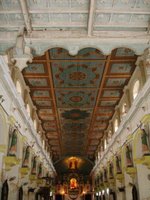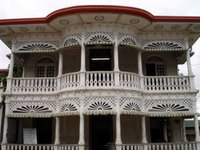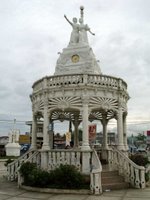 Finally, I've reached the last two provinces of northeastern Luzon Island! Yes, we visited Cagayan and Isabela today. Just like the Ilocos trip in July last year, I joined the Arch 17 class of Prof. Jojo Mata for the semestral study tour organized by the UP College of Architecture HTC Lab.
Finally, I've reached the last two provinces of northeastern Luzon Island! Yes, we visited Cagayan and Isabela today. Just like the Ilocos trip in July last year, I joined the Arch 17 class of Prof. Jojo Mata for the semestral study tour organized by the UP College of Architecture HTC Lab.We left UP at 10 p.m yesterday and arrived in Cauayan, Isabela at 6 a.m. just in time for breakfast at the Jambalaya Grill. After a hearty breakfast, we went to the Magat Dam in Ramon. Although I was surprised to see a sign along the road a few meters from the dam that we were in Alfonso Lista, Ifugao.
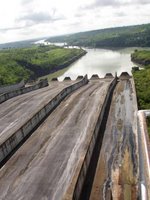 It was a massive structure which reminded me of the Marcosian-era of the Philippines, the last time when the Philippine government thought big. If there was one thing I would hand to Ferdinand Marcos and his wife Imelda, they left their legacies in architectural monuments such as the Cultural Center of the Philippines and massive infrastructure projects such as the Magat Dam. No other president after them left monumental legacies not including of course Ramos' white elephant known as Expo Filipino.
It was a massive structure which reminded me of the Marcosian-era of the Philippines, the last time when the Philippine government thought big. If there was one thing I would hand to Ferdinand Marcos and his wife Imelda, they left their legacies in architectural monuments such as the Cultural Center of the Philippines and massive infrastructure projects such as the Magat Dam. No other president after them left monumental legacies not including of course Ramos' white elephant known as Expo Filipino.From the Magat Dam, we went straight to our hotel in Tuguegarao City in Cagayan to freshen up, get some rest and have lunch. After lunch, we went to the Tuguegarao Cathedral, a heritage horror which Jojo calls a "good example of a bad example!"
 Imagine, they demolished the old brick convento right beside the church and replaced it with this horrible commercial structure and multi-purpose hall which is still under construction at this moment. Now you see why we can't entrust heritage decisions to some bishops because they themselves are at times the culprits.
Imagine, they demolished the old brick convento right beside the church and replaced it with this horrible commercial structure and multi-purpose hall which is still under construction at this moment. Now you see why we can't entrust heritage decisions to some bishops because they themselves are at times the culprits.That also happened in Lingayen, Pangasinan just recently. Instead of demolishing these centuries-old conventos and replacing them with horrible new buildings, the bishops could have contacted the NCCA or a conservation architect to consult them on how to do adaptive reuse of the conventos, meaning tranforming the interior of the conventos in order for them to serve the purpose intended for new buildings. In that manner, heritage is preserved and the bishops get the income they want.
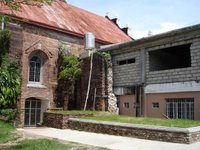 Yes, the bottomline was income for the bishops since commercial stalls replaced the old conventos when the said stalls could have been integrated properly with the old conventos had they consulted. Notice also the water tank on top of the demolished part of the convento. You can really see how some priests and bishops treat our national heritage.
Yes, the bottomline was income for the bishops since commercial stalls replaced the old conventos when the said stalls could have been integrated properly with the old conventos had they consulted. Notice also the water tank on top of the demolished part of the convento. You can really see how some priests and bishops treat our national heritage.Tuguegarao is actually an urban planning disaster having transformed itself into another nondescript Philippine city without character. Not much of its heritage is left since Church and State seemed to have formed a perfect tandem in eradicating its rich past. Add to the fact that the roads are literally congested with tricycles. Yes people! After Cabanatuan, Tuguegarao follows with the most number of tricycle franchises issued. Driving in the city streets is a nightmare since the drivers treat the roads as if they were theirs.
We then visited a horno, an oven for baking bricks, in some forgotten corner of the city. I guess the city government has no plans of caring for the site since it's already hidden in a rundown residential area right beside a basketball court which is obviously more important to the people than this relic of the past.
 But these depressing episodes would soon be forgotten as we crossed into the next town Peñablanca to visit the Peñablanca Protected Landscapes and Seascapes, in particular, the famous Callao Caves. The image of the caves is so popular owing to the little chapel inside a large cavern which receives sunlight from a natural opening above. Finally, I get to visit the famous caves. But the signature ray of sunlight wasn't there since it enters the cave only at a particular time of the day.
But these depressing episodes would soon be forgotten as we crossed into the next town Peñablanca to visit the Peñablanca Protected Landscapes and Seascapes, in particular, the famous Callao Caves. The image of the caves is so popular owing to the little chapel inside a large cavern which receives sunlight from a natural opening above. Finally, I get to visit the famous caves. But the signature ray of sunlight wasn't there since it enters the cave only at a particular time of the day.Getting up to the caves can be exhausting thanks to the 183 steps you have to climb to get to the top! But you will be rewarded with surreal rock formations that are very easy to explore.
 After the caves, we went down to the banks of the Pinacanauan River for a boat trip that offered us spectacular views of limestone cliffs covered with lush forests. Indeed, this was a reminder that the Philippines had a lot to offer and if we let all of this go by neglecting our natural heritage, it's the next generation of Filipinos that would suffer.
After the caves, we went down to the banks of the Pinacanauan River for a boat trip that offered us spectacular views of limestone cliffs covered with lush forests. Indeed, this was a reminder that the Philippines had a lot to offer and if we let all of this go by neglecting our natural heritage, it's the next generation of Filipinos that would suffer.I really hope illegal logging in this part of the country, particularly Cagayan and Isabela, is stopped. But we all know why it still goes on. If politicians in the area can't curb illegal logging, it's either they are weak and don't have the political will, or more plausible is that they are earning from it as well!
 We went back to Tuguegarao to get our long-needed rest and for dinner of course. The next day's itinerary was mostly church heritage. I'm quite excited since I rarely visit the Cagayan Valley owing to its distance from Manila. Last time I visited was in 2002 during a conference in Bayombong, Nueva Vizcaya. As part of the conference we visited the church in Dupax del Sur which is a national cultural treasure.
We went back to Tuguegarao to get our long-needed rest and for dinner of course. The next day's itinerary was mostly church heritage. I'm quite excited since I rarely visit the Cagayan Valley owing to its distance from Manila. Last time I visited was in 2002 during a conference in Bayombong, Nueva Vizcaya. As part of the conference we visited the church in Dupax del Sur which is a national cultural treasure.It looks like I'm close to completing the provinces of Luzon Island soon. With my visits to Isabela and Cagayan today, that leaves seven namely Quirino, Kalinga, Apayao, Abra, Aurora, Camarines Norte, and Sorsogon; plus of course six island provinces of Luzon which are Batanes, Occidental Mindoro, Romblon, Marinduque, Masbate and Catanduanes which I hope to visit in the near future. Hehe!



